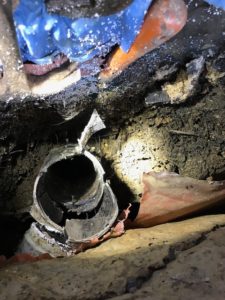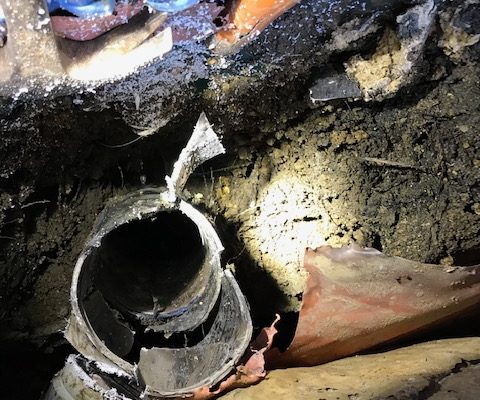When it comes to extending or building a new structure on the ground floor the type of soil in which we will be working with is important to identify. Various suburbs of Adelaide are known to have reactive soils locations such as Oakden, Lights View, Northgate and Aberfoyle Park. Our recent project was undertaken in Aberfoyle Park as you will see below.
Ground Movement When Building
A client recently contacted us to investigate some ground movement along the side of there house. The area in question was located outside two of there bathrooms and it was covered by an over head shade sail. The first thing to do was lift the pavers and see what condition the soil is in below. Immediately upon removing a few pavers it was noted that the soil was all very wet, spongey and there were air pockets present. The next step was to keep excavating until dry soil could be found, unfortunately this did not happen, and the soil continued to get more saturated the deeper we went to nearly 1 metre in depth. It was at the depth of 1 metre the soil had become black and almost 100 percent saturated, it was like digging in a swamp!
located outside two of there bathrooms and it was covered by an over head shade sail. The first thing to do was lift the pavers and see what condition the soil is in below. Immediately upon removing a few pavers it was noted that the soil was all very wet, spongey and there were air pockets present. The next step was to keep excavating until dry soil could be found, unfortunately this did not happen, and the soil continued to get more saturated the deeper we went to nearly 1 metre in depth. It was at the depth of 1 metre the soil had become black and almost 100 percent saturated, it was like digging in a swamp!
Why so much moisture this deep in the ground?
As previously mentioned, Aberfoyle Park is known for having reactive soils meaning that they are likely to shrink and expand due to the nature of its makeup. When we encounter such conditions its crucial that various precautions are put in place to protect items such as the concrete slab, external fixtures and services running under and into the building. The concrete slab is likely to have more steel installed in it and have thicker areas to help it maintain its integrity when the soils shrink and expand. Services such as plumbing drains should have expansion and swivel joints installed to allow the drains to move without causing damage to the pipes.
When the hole was further excavated, we found that the sewer drain was in this location and could well be responsible for what is allowing all this moisture into the hole. We followed the direction of the sewer drain to the underside of the perimeter footing where a small pond was found. Between the water membrane and the concrete slab was a huge amount of water just sitting there. The main sewer pipe which ran from outside the home’s perimeter and through the middle of the house to pick up the kitchen and laundry sinks had snapped in half (as seen in image) this was the cause for so much moisture in this area.
How to fix such a problem?
In order to have this issue properly fixed we needed to now engage one of our plumbers to attend the site and asses the damage. The drain was further excavated to see what condition it was in down stream as the system was still holding a large amount of waste water. The drain was exposed another few meters where it was identified as having collapsed due to ground movement in this area also. The lack of any type of flexible connections or expansion control devices certainly did not help, and the lack of quality fill being used provided a deadly combination which lead to this disaster. We would now need to identify a suitable point in which to join back onto the sewer system and then carefully re-install the drainage system with the correct swivel and expansion connections to prevent any future damage to the pipe system.
Making good of the bad situation
Once the new sewer drain had been installed using the required swivel and expansion fittings and then tested it was time to have all the contaminated spoil removed from the site and new class A material imported to begin the backfilling process. Carefully the trench was backfilled and compacted in layers to ensure good support for the pipes and for the pavers which would be re-installed. Once all backfilling was completed it would be time for our paver to attend and cut the pavers to now allow for the new inspection openings for the drain to be raised to surface and install the pavers.
Working with reactive soils is always a challenge and can cost more in the initial build stages BUT as you have just seen in this situation for the sake of a few hundred dollars’ worth of flexible connections and some good quality imported fill a situation such as this may have been avoided. When it comes to building there should never be any short cuts taken because the consequences can be disastrous.

